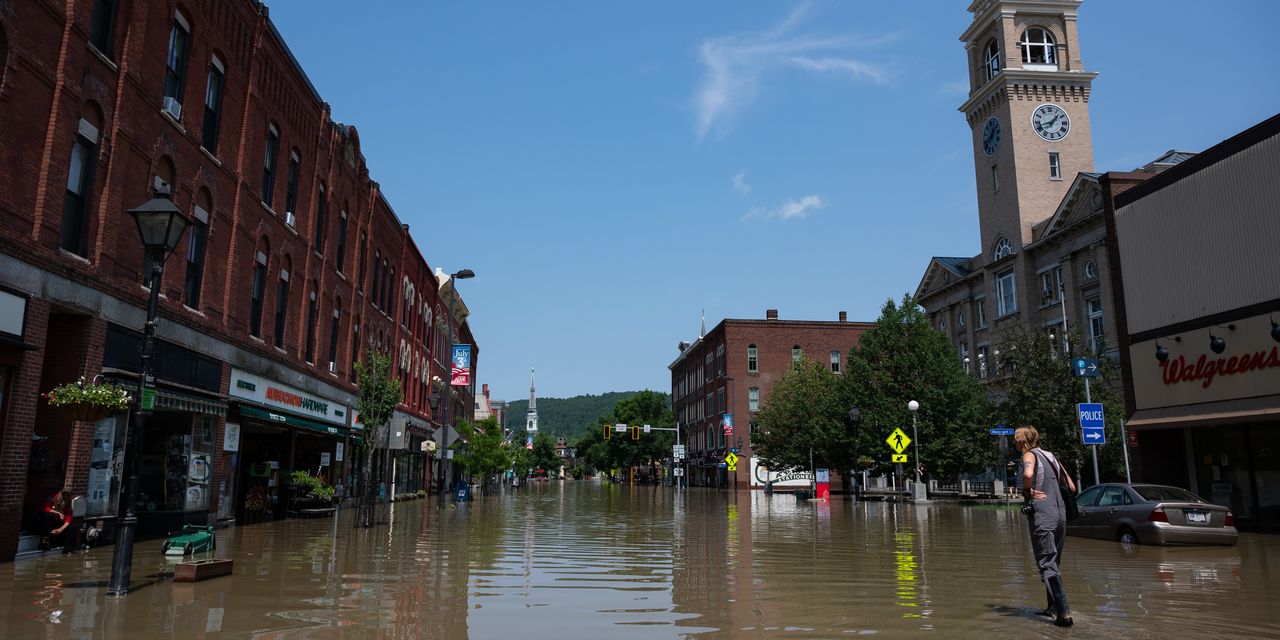A new Treasury Department report finds that more than half of U.S. counties — populated by millions of Americans — face heightened future exposure to at least one of the three leading climate hazards: flooding, wildfire or extreme heat.
And for some Americans, the report’s findings may feel even more immediate. That’s especially true at the end of a summer marked by record-high temperatures in parts of Texas, Arizona and elsewhere, costly flooding in Vermont, and compromised breathing as Canadian wildfire smoke drifted down to the U.S. Northeast and upper Great Lakes.
Just as Treasury was releasing its report Friday, New York and New Jersey officials declared a state of emergency due do dangerous flash flooding that filled basements and hampered the subway.
Read: Parts of New York City are under water. Here’s how to protect yourself from dangerous flash floods anywhere.
The report is viewed as a framework for evaluating the impacts of climate change on household finances and recommends steps to build capacity to prepare for, respond to and recover from climate-related shocks and stresses. The report also includes a catalog of specific consumer resources, including educational resources to promote awareness about the steps households can take to prepare for and adapt to climate hazards.
What’s more, the Treasury official behind Friday’s report said next steps will include a ZIP-code level review of household and business property and casualty insurance gaps, deemed especially important as select major carriers have pulled out of large states including Florida, California and elsewhere, faced with rising reinsurance costs and the unknowns intensified by climate change.
Don’t miss: State Farm cracks down on California wildfire insurance. What it means for all homeowners.
“Severe flooding, wildfires and extreme heat are imposing significant financial burdens on households across the country. This has been highlighted by recent events such as this summer’s wildfires that blanketed numerous U.S. cities with poor air quality,” said Graham Steele, Treasury’s assistant secretary for financial institutions.
“Underserved communities are particularly hard-hit by such events,” Steele said, in releasing the report that’s intended to guide policymakers and consumers in making decisions about how to insure and safeguard their health and property.
Related: More banks should join climate pledge, Treasury’s Yellen says in issuing new guidance
Why is the Treasury Department talking about climate change? Steele, who participated Friday in a discussion with the Urban Institute, explained the role is part of President Biden’s push for a whole-of-government approach to mitigating and adapting to climate change. He said the funding for the research is part of the Inflation Reduction Act, which some observers have deemed the largest U.S. climate-change effort to date.
“We see headline numbers around events like the wildfires in Maui, which could cost around $4 billion to $6 billion,” Steele said at the event. “We want to get a little bit more of a human face on these kinds of high level events and these numbers, but unpack what the impacts are on the household.”
Next steps include the growth of a pilot program through Treasury’s Federal Insurance Office, which is collecting nationwide ZIP-code level data about which households are insured against potential climate risks, including the pricing and availability of property and casualty policies.
“I think a day doesn’t go by that I don’t read an article… about how insurance companies are either raising the cost of their premiums, reducing the coverage of their policies, or just saying they’re not going to issue policies in entire states or in communities as a result of climate change,” Steel said Friday.
“We are very interested in getting more of the underlying data about that, what we actually empirically know about how the costs of insurance going up as a result of climate change or how availability is being affected as a result of climate change, and we want it as a nationwide basis,” he said.
Related: National flood-insurance program is set to expire — and could leave millions of homeowners in the lurch
And: Why is flood insurance so expensive? Florida homeowners detail struggle with rising costs
The report details financial risk to households tied to lost earnings, property damage or destruction, insurance gaps and limited access to public-benefits programs. Climate change-related weather can mean the extra expense of running air conditioning for longer periods of time, or may result in illness or injury that strains underinsured Americans especially. The report also describes indirect effects from extreme weather, such as higher prices for consumer goods when the supply chain is impacted and rising costs of gasoline and other energy as severe storms can hinder production and transport.
Don’t miss: Big-state governors aim to quadruple number of high-efficiency heat pumps in U.S. homes and buildings by 2030
Read: Here’s the surprising state getting a boost from Amazon.com’s renewable-energy projects
Though many households are impacted by climate hazards, certain households are particularly susceptible to experiencing financial strain, Treasury officials said. For example, outdoor workers face income loss due to adverse climate conditions, single-parent households led by women face reduced child care availability, and lower-income households face reduced access to credit.
Read: It’s official: This summer was the hottest on record
Heat waves, sometimes called silent killers, are already the leading cause of weather-related deaths in the U.S. and will intensify in frequency and severity as human-caused climate change increases global temperatures. Leading public-health journals and medical organizations have said climate change poses the biggest threat to public health in the coming years.
And because high healthcare costs already burden some U.S. families more than others, recent climate-change research has focused on heat and health.
A separate report from the public-policy research group Center for American Progress estimates that extreme heat resulted in $1 billion in additional healthcare-related costs in the U.S. this summer alone. That group projected that excessive heat will prompt roughly 235,000 emergency-department visits and more than 56,000 hospital admissions for conditions related to increased body temperature this summer.
Treasury’s Steele said he hopes further scope for study includes the physical and economic cost of climate-change trauma.
“I think we know that a lot of financial behavior is emotion driven. Put the stress of the climate event on top of that and you know, the threat of losing your home or your community, [and we should explore] just sort of what that does to households,” he said.
Read the full article here








